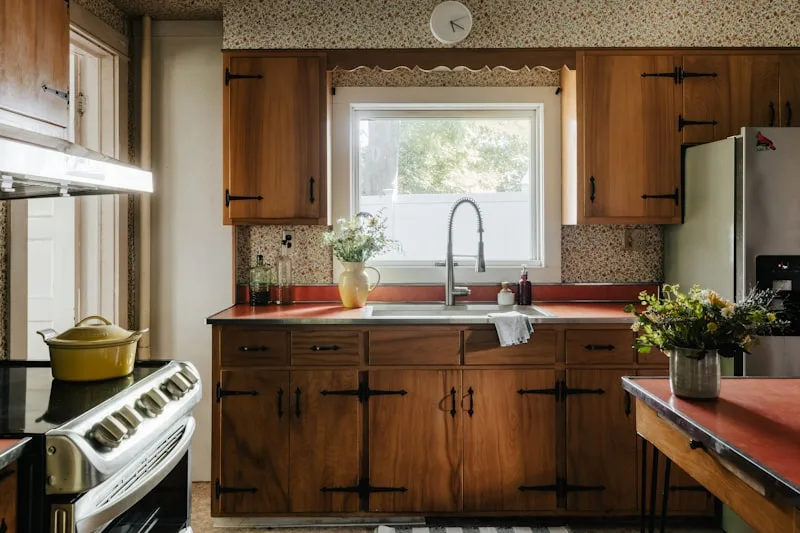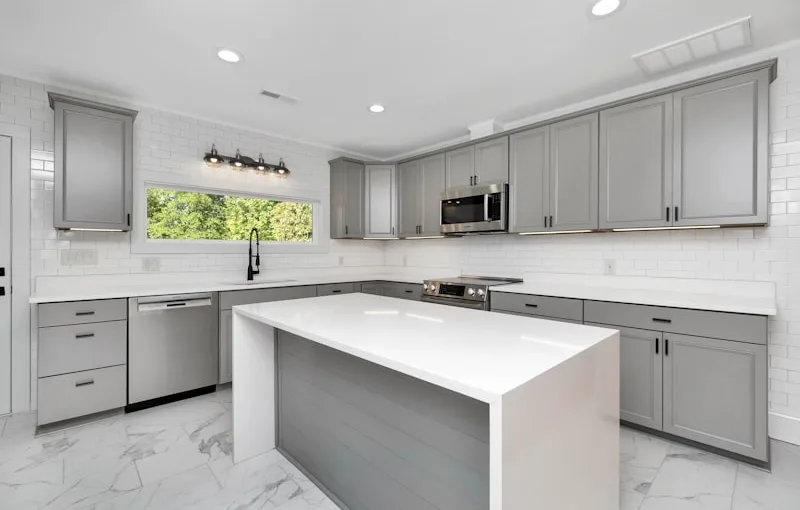First off, let’s talk about food spills. You know how it goes—one minute you’re cooking up a storm, and the next, a rogue sauce or crumb has slipped into the dark corners of your cabinet. Over time, these little accidents can turn into a smelly science experiment. Mold and mildew thrive in damp, hidden spots, creating a musty odor that can make you wrinkle your nose every time you reach for a pot.
Then there’s the issue of old food. We’ve all got that one box of pasta or bag of spices that’s been sitting there for ages, right? If you haven’t checked your pantry in a while, it might be time for a little spring cleaning. Expired items can release odors that are less than appetizing, and they can attract pests, too. Yikes!
Don’t forget about the materials your cabinets are made from. Wood, for instance, can absorb moisture and odors over time. If your cabinets are made from particleboard or MDF, they might be off-gassing, releasing unpleasant smells into your kitchen. It’s like your cabinets are trying to tell you something!
Lastly, consider the air circulation in your kitchen. A stuffy environment can trap odors, making them linger longer than a guest who overstays their welcome. Opening windows or using a fan can help freshen things up. So, next time you catch a whiff of something off, remember these tips to tackle the mystery of your smelly kitchen cabinets!
Unmasking the Mystery: Why Your Kitchen Cabinets Might Be Hiding Unpleasant Odors
First off, think about the food you store. Spices, oils, and even that half-eaten bag of chips can go stale or spoil, releasing funky smells that cling to the wood like an unwanted guest. If you’ve got any expired items hiding in the back, it’s time for a little spring cleaning—yes, even if it’s not spring!
But it’s not just the food. Moisture can be a sneaky culprit too. If your cabinets are near the sink or dishwasher, they might be absorbing humidity, creating a perfect breeding ground for mold and mildew. Imagine your cabinets as sponges, soaking up all that dampness and then deciding to share the love with a musty smell. Yikes!
And let’s not forget about the crumbs. Those little bits of food can accumulate over time, attracting pests that bring their own set of odors. It’s like inviting a raccoon to your kitchen party—definitely not the vibe you want!
So, what can you do? Start by clearing out the clutter. Toss anything expired, wipe down surfaces, and consider using odor-absorbing products like baking soda or activated charcoal. Think of them as your kitchen’s personal air fresheners, working hard to keep things fresh and inviting.
Next time you catch a whiff of something off, remember: your kitchen cabinets might be hiding more than just pots and pans. They could be concealing a whole world of odors waiting to be discovered!
From Mold to Spices: The Surprising Culprits Behind Kitchen Cabinet Smells

First off, mold is a sneaky little villain. It loves damp, dark places, and your cabinets can be the perfect hideout. If you’ve ever spilled something and didn’t clean it up right away, you might have unwittingly created a mold paradise. Just like that forgotten sandwich in your backpack, mold can grow quickly and leave a nasty smell behind.

But wait, there’s more! Spices, while they add flavor to your dishes, can also be a source of odor. Ever opened a jar of old spices and been greeted by a musty scent? That’s because spices lose their potency over time, and when they do, they can start to smell a bit off. It’s like a once-vibrant party that’s now just a dull gathering of stale memories.
And let’s not forget about the containers themselves. Plastic can absorb odors over time, especially if it’s been used for strong-smelling foods. Think of it as a sponge soaking up all the bad vibes. If your containers are starting to smell funky, it might be time for a good wash or even a replacement.
So, the next time you crack open your kitchen cabinet and get a whiff of something unpleasant, remember: it could be mold, stale spices, or even the containers themselves. It’s a wild world in there, and a little detective work might just lead you to the source of that smell!
Is Your Kitchen Cabinet Smelling Funky? Here’s What You Need to Know!
First off, let’s get to the root of the problem. Funky smells often come from food spills, expired items, or even moisture lurking in the corners. Think of your cabinet as a cozy little cave where food and spices hang out. If it’s not well-maintained, it can quickly turn into a stinky dungeon. So, what can you do? Start by emptying everything out. Yes, everything! It’s like spring cleaning, but in the middle of summer. You’ll be surprised at what you find—old spices, forgotten snacks, and maybe even a mystery item that’s been hiding for ages.
Once you’ve cleared it out, give the shelves a good wipe down with a mixture of vinegar and water. Vinegar is like nature’s deodorizer; it’ll zap those odors away faster than you can say “kitchen makeover.” If the smell persists, consider placing an open box of baking soda inside. It’s like a sponge for odors, soaking them up and leaving your cabinet smelling fresh.
The Hidden Dangers: How Unpleasant Smells in Your Cabinets Could Signal Bigger Problems
Imagine this: you’re reaching for a favorite dish, and suddenly, a musty odor wafts up. What’s going on? Often, these smells can indicate moisture problems, which can lead to mold growth. Mold isn’t just a nuisance; it can pose serious health risks, especially for those with allergies or respiratory issues. It’s like a hidden villain, quietly wreaking havoc while you’re blissfully unaware.
But wait, there’s more! Unpleasant smells can also signal pest infestations. Rodents and insects can leave behind droppings or decaying food, creating a cocktail of odors that’s hard to ignore. If your cabinets are starting to smell like a science experiment gone wrong, it might be time to investigate. After all, who wants to share their kitchen with uninvited guests?
And let’s not forget about the possibility of plumbing issues. A foul odor could mean a leak or a blockage, which can lead to water damage and costly repairs. It’s like a ticking time bomb, waiting to explode if you don’t take action.
So, the next time you catch a whiff of something off in your cabinets, don’t just brush it off. Dive deeper, investigate, and tackle those hidden dangers before they escalate into bigger problems. Your home—and your health—will thank you!
Frequently Asked Questions
What Causes Unpleasant Smells in Kitchen Cabinets?
Unpleasant smells in kitchen cabinets can be caused by various factors, including food spills, mold growth, and moisture accumulation. Improperly stored food items, expired products, or leaks can contribute to odors. Regular cleaning and proper ventilation are essential to prevent and eliminate these smells.
What Are Effective Ways to Eliminate Bad Smells from Cabinets?
To eliminate bad smells from cabinets, start by emptying the contents and cleaning the surfaces with a mixture of vinegar and water. Place an open box of baking soda or activated charcoal inside to absorb odors. Ensure proper ventilation by leaving the cabinet doors open for a few hours. Additionally, consider using essential oils or odor-neutralizing sprays for a fresh scent.
How Can I Prevent Future Odors in My Kitchen Cabinets?
To prevent future odors in kitchen cabinets, ensure proper ventilation by keeping doors slightly ajar when not in use. Regularly clean the interiors with a mixture of vinegar and water to eliminate lingering smells. Store food items in airtight containers and avoid placing expired products inside. Additionally, consider using odor absorbers like baking soda or activated charcoal to maintain freshness.
How Can I Identify the Source of the Odor in My Cabinets?
To identify the source of an odor in your cabinets, start by removing all items and inspecting for any spills, mold, or expired products. Check for signs of pests or moisture, as these can contribute to unpleasant smells. Clean the surfaces with a mixture of vinegar and water to neutralize odors. If the smell persists, consider placing an open box of baking soda inside the cabinet to absorb any remaining odors.
Are There Specific Foods or Items That Cause Smells in Cabinets?
Certain foods and items can emit odors that linger in cabinets. Common culprits include expired or spoiled food, strong-smelling spices, and certain types of cheese. Additionally, items like onions, garlic, and fish can leave persistent smells. To prevent odors, store food in airtight containers and regularly check for expired items.
